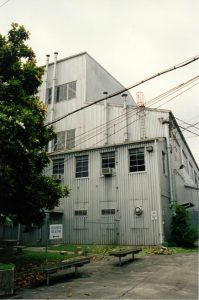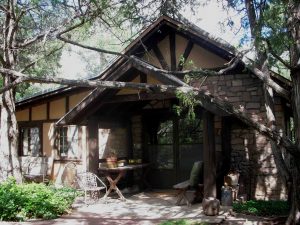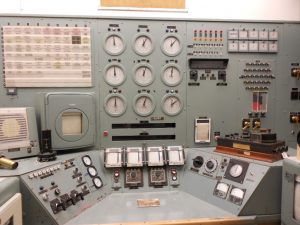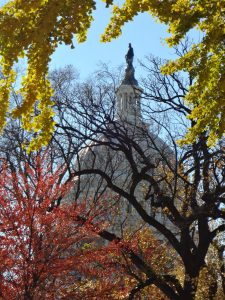Congress Establishes Manhattan Project National Historical Park

On December 12, 2014, the Senate passed the 2015 National Defense Authorization Act (NDAA), which includes a provision to establish a Manhattan Project National Historical Park (Manhattan Project NHP) at Los Alamos, NM; Hanford, WA; and Oak Ridge, TN, by a vote 89-11. The House passed the 2015 NDAA legislation on December 4, 2014 by vote of 300-119. President Obama signed the bill into law on December 19, 2014.
On November 10, 2015, the Atomic Heritage Foundation welcomed the official establishment of the Manhattan Project National Historical Park with units at Los Alamos, NM, Hanford, WA, and Oak Ridge, TN. In a ceremony at the Interior Department, U.S. Secretary of Energy Ernie Moniz and Secretary of the Interior Sally Jewell signed an agreement that defined the respective roles of the Department of Energy and the National Park Service in implementing the new park.
No national monument or park previously existed to preserve and interpret the historic properties of the Manhattan Project. As Cynthia C. Kelly, founder and president of the Atomic Heritage Foundation, said, “The national park is long overdue and will provide Americans an important opportunity to understand the Manhattan Project and its complex legacy for the world today.”
The new Manhattan Project NHP is one of the few that focuses on American science, technology and industry. Noted for its path-breaking inventions, the Manhattan Project offers an excellent opportunity to engage the public in learning about innovation in science, engineering and technology. Interpretation of the park will also prompt reflection on the decision to drop the atomic bomb on Japan and on the extent to which scientists should be accountable for their inventions.
The Manhattan Project reflects the diversity of the American experience with over 600,000 working on the project around the country. Participants included eminent scientists at Los Alamos, NM who were refugees from Nazi regimes. Others were only high school girls from rural America who operated the control panels at plants in Oak Ridge, TN. In isolated, hastily built communities, the Manhattan Project enforced strict secrecy on the hundreds of thousands of people who worked without knowing what they were producing.
Richard Rhodes, Pulitzer Prize-winning author of The Making of the Atomic Bomb and a Board Member of the Atomic Heritage Foundation, commented, “The new weapon was built in makeshift buildings, laboratories and factories all over the United States. Now nearly 70 years later, some of these historic places of the Manhattan Project will at last be preserved as part of the national historical park. The Manhattan Project is significant not only for its role in ending World War II but for introducing a major new force in human affairs. Reason enough to be remembered.”
Manhattan Project NHP Sites

The Oppenheimer House at Los Alamos
The new park has three major sites: Los Alamos, NM, where the first atomic bombs were designed; Oak Ridge, TN, where enormous facilities produced enriched uranium; and Hanford, WA, where plutonium was produced. There are over 40 properties that are officially designated as part of the park with provision for adding others later.
Los Alamos, NM: The new park includes 13 properties in the Los Alamos community, many of them originally built by the Los Alamos Ranch School in the 1920s. The top-echelon scientists and military leaders lived in the only seven houses with bathtubs on a street known as Bathtub Row.
The cottage where J. Robert Oppenheimer and his family lived could be the “jewel in the crown” of the new park. Right next door, the Bethe House was restored by the Los Alamos Historical Society to interpret the Manhattan Project and Cold War. Fuller Lodge, a handsome ponderosa pine structure, was a social center for the Manhattan Project and remains an important community facility.
More than a dozen other properties are owned by the Los Alamos National Laboratory. Public access to some of these properties will be limited for the first few years to address security issues. This includes the V Site buildings, saved from demolition in 1998 and restored in 2006, where the “Gadget,” detonated at the Trinity Site on July 16, 1945, and other “Fat Man” bombs with plutonium cores were assembled.
Public access will also be limited at the Gun Site, which was used to develop and test the “Little Boy” or uranium-based bomb. This site is undergoing reconstruction but will eventually have a concrete bunker, periscope tower, cannons and a firing range.
Oak Ridge, TN: The mission of the Clinton Engineer Works was to produce enriched uranium, one of the core ingredients of an atomic bomb. Mammoth plants at Y-12 and K-25 used different techniques (electromagnetic separation and gaseous diffusion) to produce enriched uranium. The mile-long K-25 building was completely demolished in 2013. Current plans are to build a partial recreation and interpretive center for visitors if sufficient funding is available.
The “Calutron girls” worked at another signature facility at the Y-12 plant. These young women who deftly operated the controls were made famous by the recent best-seller, “The Girls of Atomic City.” While security and restoration costs are an issue, we hope that visitors will eventually be able to tour the remaining “Calutron” building at Y-12.
A third site at Oak Ridge is the X-10 Graphite Reactor, a pilot-scale reactor and prototype for the Hanford plutonium production reactors. This has been open to the public for several decades though on a more limited basis since 9/11.
Hanford, WA: The B Reactor, the world’s first full-scale plutonium production reactor, has welcomed visitors for several years. The T Plant is a mammoth plant used to chemically separate plutonium from irradiated fuel rods, one of the first remotely operated industrial processes. Currently the plant is in use but eventually the public may access a small portion to see where the operators remotely managed the processes three stories below them.
In addition, four pre-World War II properties located along the Columbia River will be preserved: the Hanford high school, White Bluffs bank, an agricultural warehouse owned by the Bruggemann family, and an irrigation pump house. Here visitors will hear the stories of the pioneering agricultural families as well as the Native Americans who lived, hunted, fished, and camped near the Columbia River.
The Making of the Manhattan Project Park

The control room of the B Reactor
In 2003, Congress required DOE to develop a plan for preserving its Manhattan Project history. Under a cooperative agreement with DOE, the Atomic Heritage Foundation took on the task, beginning with a series of public meetings at Oak Ridge, TN, Los Alamos, NM, and Richland, WA. The Foundation’s report released in 2004 recommended a Manhattan Project national historical park at the three major sites.
In September 2004, Congress passed the Manhattan Project National Historical Park Study Act [PL 108-340] that authorized the National Park Service to study whether to create a Manhattan Project National Historical Park. In June 2011, the National Park Service recommended that Congress establish a national historical park with units at Los Alamos, Oak Ridge, and Hanford.
For more about how the park came to be established by Congress, see AHF President Cindy Kelly’s article, The Making of the Manhattan Project Park, published by the Federation of American Scientists.
Related AHF Efforts

Over the past decade, the Atomic Heritage Foundation has partnered with the local Manhattan Project sites, the National Parks Conservation Association, the National Trust for Historic Preservation, and the Energy Communities Alliance to urge Congress to establish a Manhattan Project National Historical Park and preserve these sites for posterity.
When future generations look back on the 20th century, few events will rival the harnessing of nuclear energy as a turning point in world history. Having some of the authentic properties where the Manhattan Project scientists and engineers achieved this is essential. As Richard Rhodes has said, “When we lose parts of our physical past, we lose parts of our common social past as well.” With the Manhattan Project National Historical Park, our vision of having some tangible remains from the Manhattan Project to educate and inspire future generations may become a reality.
In the meantime, the Atomic Heritage Foundation is continuing its work to preserve key Manhattan Project properties. For more information, see:




